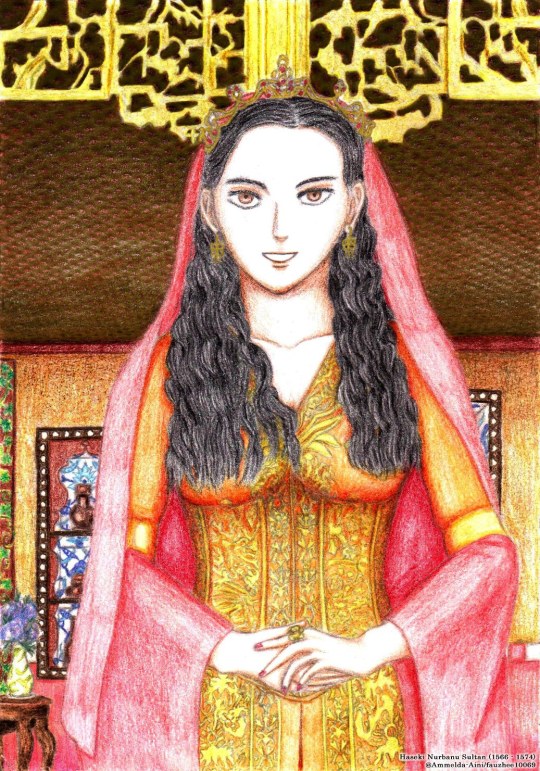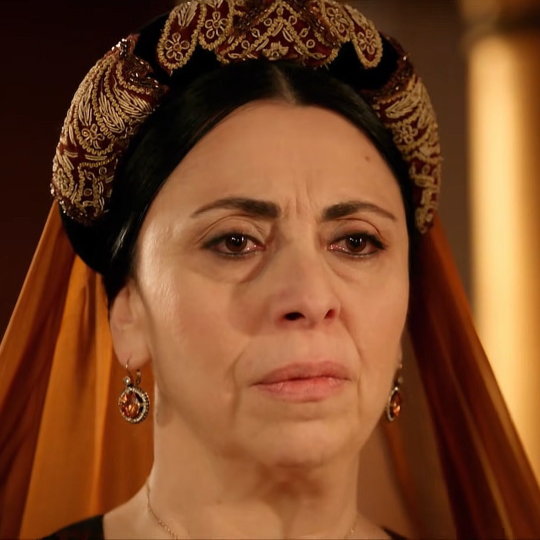#Safiye Sultan (Harem of Murad III)
Explore tagged Tumblr posts
Text




This brown fur coat is first worn by Safiye Sultan in the tenth episode of the first season of Magnificent Century: Kösem. It appears again on Kösem Sultan in the eighth episode of the second season.
#Muhteşem Yüzyıl: Kösem#Magnificent Century Kösem#Magnificent Century Kosem#period drama#costume drama#historical drama#Safiye Sultan#Safiye Sultan (Harem of Murad III)#Kösem Sultan#Kosem Sultan#reused costumes#recycled costumes
27 notes
·
View notes
Note
Excuse me, but I also think that Murad and Safiye did not have a daughter named Mihrimah.
The problem of your work as a historian is that you only pay attention to the writings of the ambassadors and ignore the documents of the harem.
In Mustafa Altun's book, (Yüzyıl Dönümünde Bir Valide Sultan: Safiye Sultan'ın Hayatı ve Eserleri) the rights of women in the sultan's court are specified in the final pages of the book. It is mentioned how much Sultan's sisters and cousins received. Even the names of the Sultan's four children, Mehmed, Mahmud, Ayşe and Fatma, are mentioned, but there is no name of another child.
It is more interesting that this information covers up to 1582. If Safiye had another child, most likely they would have died in infancy. If she was an older girl, her name would definitely be mentioned in the list of harem women. If Safiye had another daughter, Ahmad would have named her on one of his daughters, as he did with the others.
The previously mentioned ambassadors each say the opposite. One says that the Sultan has one daughter, while the other says that the Sultan has two daughters. It is clear that not all ambassadors could have correct information about the Sultan's family.
I think the problem of my work as a historian is that you guys ask about stuff that actual historians find in a lifetime while I have to answer in a couple of weeks. Also, I don’t have harem registers at hand and I cannot fly to Istanbul to look at them. In short, I’m doing my best with the sources I have on my pc.
I have my problems with those harem registers because while I appreciate them for showing us that Bayezid’s daughter Hatice went back to the harem at some point in her life (probably after a marriage), I don’t see Mihrimah (Süleyman and Hürrem’s daughter), who was alive in 1576:

In the top part there’s Murad III’s immediate family, so Safiye and his sons (Ayse and Fatma weren’t born yet). In the middle part we have expenses for clothes, but in the bottom part we have those who ate at the imperial kitchen and it seems strange to me that Mihrimah is not included. Also, where is Fatma binti Selim II? She was alive at the time.
Ironically, Fatma reappears after her supposed death (1580) in harem registers dated 1581-82. Either this is a mistake by the harem clerk or she didn't die in 1580 after all.

On the other hand Şah has disappeared because she truly died in 1580, it seems.
It it interesting that a historian like Uluçay missed these harem registers where Fatma is considered alive in 1581-82.
On the other hand, maybe these harem registers are not complete. Or they’re wrong.
In any case, a Mihrimah Sultan binti Murad III definitely existed, and maybe Mehmed Sureyya was wrong when he said that she was the eldest when Murad died. Or maybe we were wrong and she was the eldest when she died, therefore moving her date of birth forward.
EDIT: Fatma Sultan binti Selim II died on 24 June 1590, according to Seyyid Lokmân, Mustafa Selaniki, and İsmail Hâmi Danişmend (Lokmân and Selaniki were contemporaries). Mehmed Süreyya's Şaban 988 instead of Şaban 998 seems just an oversight. Thanks to @rhaenahanzades and @kehribar-sultan for pointing it out.
12 notes
·
View notes
Text

~Halime Sultan~
Her exact date of birth is unknwon. Most historian agree that she was a woman of abkhazian origin.She gave birth to at least four childern to Sultan Mehmed III. Her first and last child have a age differnce of 15 years what suggest that she was clearly the favorite consort. After the death of princes Süleyman and Selim, sons of Handan Sultan, Halime's son Mahmud was the eldest living son. But Mehmed III never named him as his heir. In fact, he saw him as a threat because Mahmud was popular among soliders. Mahmud often spoke against his grandmother, Valide Safiye Sultan. Once, Halime wrote a letter to a seer and asked if her son would ascend the throne, the reply letter came and the seer wrote, that Mahmud would ascend the Throne within 6 months after unpleasant thing happend to Mehmed III. The reply letter unfortunately never reached Halime but her mother in law, Safiye. Mehmed III executed his son Mahmud and Halime was exiled to Old Palace. In fact, it was belived for centuries that Halime was executed along with her son. After Sultan Mehmed's death, Ahmed I ascended the throne. He didn't execute Halime's youngest son Mustafa and thus stopped the fratricide law. But he created cages , appartments where the survived princes lived without right of proper education and right of having harem. After Ahmed's death, Halime's son Mustafa acended the throne. But his reign didn't last long because after all this years spent in kafes, he suffered of mental problems. Mustafa was dethroned and locked up again and Ahmed's son, Osman ascended the Throne. Four years later, Osman was deposed and Mustafa ascended the throne again. Halime worked hard to built alliances and urged to appoint her son in law, Davut Pasha as grand Vezir. Halime and Davut ruled the Empire. Davut Pasha was found guilty of execution of Sultan Osman 2 and was executed in 1623. Halime wothout Davut's help couldn't rule the empire. She made a deal with Kösem Sultan, that Mustafa is going back to kafes and Kösem's son Murad would ascend the throne. Halime moved back to Old Palace. She lived there forgotten. It is unknown when she died but since she is buried in Mustafa's türbe in Hagia Sofia. This suggest that she died after Mustafa who died in 1639.
youtube
14 notes
·
View notes
Text
About the Haseki title
Yesterday was the anniversary of Hafsa Valide Sultan's death. For this reason, I would like to talk a little about the Haseki title as it was created due to her death.
Origin of the Haseki title
The title itself was created in 1534 by Suleyman I. The reason is more complicated than we would think at first. Usually, we believe that Suleyman created this title for Hürrem because he loved her so much that wanted to give her something valuable. But it's not only about his love and affection for Hürrem, the whole title had a deeper meaning.
Suleyman went a lot to war in his early-mid reign. During the wars, his mother was left in the capital to take care of his harem and act as a messenger for him. Hafsa was great for that role because Suleyman could trust her, she told him everything that happened, she was respected by everyone and she could take great care of Suleyman's family. So Suleyman could be calm, everything stayed fine in the capital while he was far away. Suleyman - and every sultan - needed a strong and honest and trustworthy ally in the capital during war-time, especially when war seemed to be long and hard. For example, his father Yavuz Selim I made Suleyman act as a regent while he was chasing his brothers and fighting against them. True that these times Suleyman was not in Topkapi Palace, Istanbul but Edirne, because that was the custom. So until 1534, Suleyman could leave the capital in relative calmness because the city was in the hands of his mother, and also his mother was there to keep safe the harem and take care of his children and family.
But everything changed in 1534, in the year of Suleyman's hardest campaign. Suleyman's Persian campaign started and these kinds of campaigns were the hardest and most dangerous campaigns for the Ottomans. The wars with the Safavids are legendary! In such a situation Suleyman's mother fell ill, very ill. This is why Suleyman didn't leave with his army in early 1534 but sent Ibrahim Pasha instead. This was the first time that he did not accompany his army. At first, the army was fine with it, at least there is no evidence suggesting otherwise. Most probably they knew the reason why the sultan stayed and understood him. But with time as the war became worse and worse, Suleyman was very needed at the battlefield. Hafsa Sultan in the end died on 19 March of 1534. After the mourning period, Suleyman should leave and join his army already. But who he could trust to keep the harem and the city safe? All of his trusted men were at the campaign and the only person he could trust, Hürrem, was not suitable for the position. In the end, Suleyman named his younger son, Mehmed as the protector of Istanbul, but he was young also. Mehmed moved to Topkapi Palace with his mother and tutor, but still, it was not enough. Hürrem was the only one Suleyman could completely trust, so he must have to make her suitable for the role.
But how could a simple consort rule the whole harem and help the young protector of Istanbul? Hürrem was the mother of a prince, which definitely was something but still, she was very far from the highest-ranking women of the harem. In the harem, there lived Suleyman's widowed sisters and aunts, who all had a higher rank than Hürrem. Most of them were even older than Hürem and age was a very important factor in the hierarchy especially together with ranks. How could Hürrem rule over them? How could Hürrem with a lower rank keep the harem in order? Well, there was no way for that, so Hürrem must have had a higher rank to do so. Suleyman was thinking about what he could do... When the mourning period ended he immediately married Hürrem in May 1534. She became a wedded wife and stuff so she had a high rank but she still was only a Hatun, as only the trueborn princesses and the Valide could have the title "Sultana". As a wedded wife she still was not completely above the old true-born sultanas. Suleyman wanted to mark Hürrem's importance and position for everyone, to make it even more clear that she is Suleyman's favorite and only woman, his ear in the capital while he is abroad. So he created a new rank for Hürrem: the Haseki Sultan title. As a wedded wife and a Haseki she had a higher rank than anyone else in the Harem, she became a Sultana. And with such titles, she could easily move to Topkapi Place with Sehzade Mehmed to act as regents while Suleyman was far away. They - along with Mehmed's tutor - did a nice job, wrote letters to Suleyman about everything, and kept the harem and the city in order.

But what was the Haseki's role?
The original usage of Haseki Sultan title meant that she was the chief consort of the sultan with special status. A Haseki Sultan had an important place in the palace, being the second most powerful woman and enjoyed the greatest status in the imperial harem after Valide Sultan and usually had chambers close to the sultan's chamber. Rumors have it that Suleyman and Hürrem had a secret corridor between their rooms so they could meet anytime. When the position of Valide Sultan was vacant, a Haseki took the Valide Sultan's role, have access to considerable economic resources, become chief of the imperial harem, sultan's advisor in political matters, and even have an influence on foreign policy and international politics. So this was the original meaning of being a Haseki.
What happened later?
After Hürrem the next Haseki Sultan was Nurbanu Sultan, mother of the heir, later Murad III and partner of Selim II, Hürrem's son. When Selim ascended the throne Hürrem was already dead, so the position of the Valide Sultan was vacant. This is why Nurbanu could act similarly to Hürrem. She had a less long tenure, as Selim was sultan for only 8 years, but her power and work were very similar to Hürrems. Hürrem was the only woman in Suleyman's life after they met and she was the mother of all his children except Mustafa, who was born long before Hürrem and Suleyman met. Nurbanu was similarly to the only woman in Selim's life, however, their situation was different. Due to the law of fratricide, Nurbanu and Selim stopped reproducing after the birth of their first son in 1546. They never had any children together again, but still, they were faithful to each other and Nurbanu acted as a companion and partner, and ally to Selim. Later when their son, Murad got his first province, Nurbanu had to leave with him, leaving Selim alone. The alone Selim during this period accidentally impregnated a consort and had a daughter with her. From then on Selim was loyal to Nurbanu again and the mother of the daughter couldn't have any position or any special wealth. Selim ascended the throne in 1566 and his pashas were worried because he had only one son, one heir, the son of Nurbanu, Murad. So the pashas in the end pushed Selim to produce more children. The mothers of these children were one-night stands and they had a shamefully low stipend (50 aspers for a day) compared to Nurbanu's stipend (1100 aspers for a day). Selim wanted to show everyone that these women and these sons born from these one-night stands mean nothing compared to Nurbanu and Murad, so he stated that his heir is Murad, and his love is Murad's mother. So he married Nurbanu. So all in all true, that Selim had other women in his life besides Nurbanu but we cannot compare any of them to Nurbanu. And in general, Nurbanu had a very similar role as Hürrem so we can consider them being both the original kind of Hasekies.
When Selim II died his son Murad III took his place, and Nurbanu reached her peak, becoming a Valide Sultan. Murad to sign his love for his mother made a legal and official title out of Valide Sultanship (though it's a different story). Murad immediately made his favorite consort, Safiye a Haseki Sultan, however this time Haseki meant a different thing. The whole Haseki title was created because of the absence of a Valide Sultan and both titles have similar tasks so the two titles were incompatible. Still first time in history there was a Valide Sultan (one of the strongest of all time) and a Haseki Sultan. Both were very loved by the sultan, and both wanted to influence the sultan. This naturally caused trouble. The Haseki Sultan, Safiye wanted to be such a Haseki as Nurbanu and Hürrem were previously, but it was not possible with the presence of such a Valide Sultan. Safiye, while was a Haseki, was considered more like a favorite consort by people. Things changed when Nurbanu died in 1583 and so Safiye became a real Haseki Sultan, acting like a Haseki Sultan. However besides her Murad continuously had other consorts and these consorts had a bigger value than previously Selim II's late consorts. Some of them could to charitable foundations, which suggest a higher stipend than Selim II's late consorts. All in all of course none of them couldn't be compared to Safiye, but still, they were present.
When Murad III died, Safiye became the Valide Sultan to Mehmed III and so reached her peak in power. Safiye Sultan knew how terrible A Valide could be to a Haseki and vica versa, this is why she forbade to her son to make a Haseki out of any of his consorts. During Mehmed's reign, there was no recorded Haseki Sultan.
When Mehmed died his barely 13 years old son, Ahmed I ascended the throne in 1603. Soon he made his favorite consort, Kösem a Haseki Sultan. Kösem was a strong Haseki Sultan, but she was not similar in tasks or any other perspective to Hürrem and Nurbanu, who were the original kind of Hasekies. Kösem's situation was similar, because Ahmed's mother died young, so the Valide Sultan's position was vacant, but she couldn't make power out of the harem. She couldn't take the Valide Sultan's job. She had no political activity, she tried in vain to gain any political influence, Ahmed never let her do so. She couldn't really have her allies, she didn't have heavy burdens on her shoulders such her predecessors had. She was not even the one ruling the imperial harem as it was ruled by Haci Mustafa Agha, the chief black eunuch, who was a father-figure to the sultan. During this period the Haseki title had a meaning of being the sultan's favorite, and not being a kind-of-valide.
The next years were chaotic for the Haseki title. The new ruler after Ahmed I who had a Haseki was Osman II. Osman II's Haseki did not have any political influence, was not ruling the harem (while the position of Valide Sultan was vacant though). We cannot even consider her any kind of Haseki, only her stipend suggests she was a Haseki but nothing else.
The next sultan, Murad IV had a Haseki, Ayşe Sultan who was similar to Osman II's Haseki, as she also couldn't gain any political or another kind of influence. And in his late reign, Murad IV made a second Haseki out of his favorites. With this, the original meaning and the whole raison d'etre of it were destroyed.
The Haseki Sultan title was destroyed by Murad, but his brother Ibrahim I made a total mess out of it. He gave a Haseki title and Haseki stipend to all of his favorites, so during his reign, there was a total of 8 Hasekies. These women cannot be compared to the original Hasekies but not even to Murad IV's Haseki, Ayşe. The Haseki title was devastated and it seemed like it will end like this.
A little light came then, with the reign of Mehmed IV, who made his favorite consort, mother of his children a Haseki Sultan. Emetullah Rabia Gülnüş was again a kind of normal Haseki Sultan. She had political power, she influenced the sultan, but the role of Valide Sultan was not vacant, as Mehmed IV's mother, Turhan was alive, so she couldn't act as an original Haseki. She was similar to Kösem Sultan actually. While Emetullah Rabia Gülnüş had a Valide mother-in-law, we still cannot compare this to Safiye and Nurbanu, because those two fought with each other, while Turhan and Emetullah had a cordial relationship. True that Emetullah was not as strong and independent as the original Hasekies but after the mass of Ibrahim I, it was a refreshment to see a kind-of-Haseki-Sultan.
Mehmed IV's brother, Ahmed II had a Haseki also, Rabia Sultan, but this woman was nothing like a Haseki should be. She had the salary of a Haseki but that's all. She didn't have any kind of influence, so in reality, she was more like a simple favorite than a Haseki Sultan. The Haseki Sultan title was soon abolished and in general, the whole harem system changed a lot, the titles of the harem concubines changed also. With the death of Rabia, the last Haseki Sultan, the Haseki title disappeared.

* * *
Tegnap volt Ayşe Hafsa Valide szultána halálának évfordulója. Ennek okán szeretnék egy kicsit beszélni a Haszeki szultána címről, amely részben halála miatt jött létre.
A Haszeki cím eredete
A címet magát I. Szulejmán alkotta meg 1534-ben. Ennek oka bonyolultabb volt, mint azt először gondolnánk. Általában úgy hisszük, Szulejmán azért alkotta meg ezt a rangot Hürrem számára, mert annyira szerette és ki akarta fejezni, mennyit jelent neki. A cím azonban nem csupán a szerelemről szól, sokkal mélyebb jelentése és jelentősége van.
Szulejmán uralkodásának korai-középső periódusában rendeteget háborúzott. A háborúk idején édesanyja a fővárosban maradt és vigyázott a háremre, mindenről beszámolt a szultánnak, ami a fővárosban zajlott. Hafsa nagyszerűen megfelelt erre a szerepre, mert Szulejmán megbízhatott benne, Hafsa mindent elmondott fiának, ami történt és nagyszerűen gondját viselte Szulejmán családjának, emellett pedig mindenki szerette és tisztelte. Szulejmán ilyen háttérrel nyugodt lehetett a háborúban is, hiszen családja és a főváros jó kezekben volt. Szulejmánnak - és minden más szultának is - hatalmas szüksége volt erős, megbízható emberekre, akiket a fővárosban hagyhatott háború idejére, különösen ha hosszadalmas háború volt kilátásban. Példának okáért Szulejmán apja, I. Yavuz Szelim saját fiát, Szulejmánt hagyta meg Isztambul őrzőjének, amíg ő a keleti fronton harcolt vagy saját testvéreit üldözte. Igaz, Szulejmán nem Isztambulban volt ekkor, hanem Edirnéből kormányozta az országot és vigyázott a rendre, hiszen a hagyomány így követelte. Lényegében tehát 1534-ig Szulejmán nyugodtan hagyhata hátra a fővárost, ha háborúzni ment.
1534-ben aztán minden megváltozott. Ebben az évben indult Szulejmán egyik legkeményebb hadjárata, a perzsa hadjárat. A Szafavidák ellen vívott háborúk mindig a legnehezebbek voltak az oszmánok számára, nem volt ez másként Szulejmán esetében sem. Ilyen körülmények között azonban, pont a hadjárat előkészületei alatt Hafsa szultána súlyos beteg lett. Szulejmán nem akarta elhagyni édesanyját, ezért hadseregét előreküldte Pargali Ibrahim vezetésével, ő maga pedig anyja mellett maradt. Ez volt az első alkalom, hogy Szulejmán így cselekedett. Úgy tűnik, a hadsereg nem különösebben bánta eleinte Szulejmán döntését, bizonyára tudták, mi távollétének oka és megértették. Később, ahogy a hadjárat egyre rosszabbul ment, Szulejmánra nagy szükség volt a hadszíntéren. Hafsa végül március 19-én hunyt el. A gyászidő letelte után Szulejmánnak el kellett volna indulnia hadserege után, azonban nagyon nehéz helyzetben találta magát. Nem tudtakire bízza a háremét és a fővárost. Bár kinevezte fiát, Mehmedet Isztambul védelmezőjévé, a herceg még nagyon fiatal volt ekkor. Mehmed herceg anyja és tanítója kíséretében a Topkapi Palotába költözött, ám ez kevés volt. Hürrem volt az egyetlen, akiben Szulejmán kellőképpen megbízott, hogy ráhagyja a háremet és a fővárost, azonban a nőnek nem volt megfelelő rangja ahhoz, hogy elláthassa ezt a feladatot.
Hogyan uralhatta volna egy egyszerű ágyas a háremet és hogyan segíthette volna Isztambul ifjú őrzőjét? Hürrem bár több herceg anyja volt és a szultán kedvence, mégis nagyon távol állt rangban a hárem sok más lakójától. A háremben éltek ugyanis Szulejmán özvegy testvérei, nagynénjei, akik mint rangban, mind korban felülmúlták Hürremet. Hogy uralkodhatott volna tehát Hürrem? Szulejmán végül feleségül vette kedvenc ágyasát, Hürremet 1534 májusában. Ezzel bár hites feleség lett és pozíciója sokat javult, továbbra is csak a Hatun rang illette meg, nem uralhatta tehát a háremben élő született szultánákat. Szulejmán ezért megalkotott egy olyan rangot Hürrem számára, amellyel maga is szultána rangot kapott, így pedig alkalmassá vált arra, hogy a háremet uralja. A Haszeki szultána rang megalkotása után mindenki számára nyilvánvalóvá vált, hogy mit jelent Hürrem a szultán számára, és kénytelenek voltak elfogadni felsőbbrendűségét. Ezekután Hürrem fiával együtt nyugodtan költözhetett a Topkapi Palotába, ahonnan rendszeresen számoltak be a szultánnak az aktuális eseményekről. Jó munkát végeztek, így Szulejmán nyugodtan koncentrálhatott hadjáratára.

Na de gyakorlatban mi volt a Haszeki szultána feladata?
Eredetileg a Haszeki szultána cím a szultán fő kedvencét jelölte, akinek kiemelt státusza volt. A Haszeki szultána nagyon fontos szerepet játszott a háremben, és a második legbefolyásosabb nő lehetett a Valide szultána után. Emellett megvolt a saját lakrésze, mely a validéével vetekedett. A legendák szerint Hürrem lakrésze például titkos összeköttetésben állt Szulejmánéval, hogy zavartalanul találkozhassanak. Ha a Valide Szultána hiányzot a hierarchiából, a Haszeki vette át feladatait, amivel hatalmas gazdasgi forrásokhoz jutott hozzá, ő volt a hárem feje, a szultán tanácsadója politikai ügyekben, sőt akár befolyással lehetett a más államokkal vlaó politikára is. Ezt értjük tehát a Haszeki cím eredeti jelentőségének.
Mi történt később?
Hürrem után a következő Haszeki, Nurbanu szultána volt, az örökös, későbbi III. Murad anyja és II. Szelim partnere. Amikor Szelim trónralépett, Hürrem már régóta halott volt, így a Valide szultána rang üres volt. Ennek köszönhetően Nurbanu hasonló keretek között ténykedett, mint elődje, Hürrem. Haszekisége csupán 8 évig tartott, mely alatt hatalma, munkája nagyban hasonlított Hürremére. Szulejmán életében nem volt más nő miután megismerte Hürremet és ő volt minden fiának anyja, kivéve Musztafának, aki jóval idősebb volt Hürrem fiainál. Nurbanu hasonlóan az egyetlen nő volt Szelim életében, azonban esetük kissé eltérő volt. A testvérgyilkosság törvénye miatt Szelim és Nurbanu első fiuk születése után nem nemzett többé gyermeket, azonban hűségesek voltak egymáshoz és Nurbanu vált Szelim partnerévé, társává. Később, mikor egyetlen közös fiuk megkapta első uralnivaló provinciáját, Nurbanu a szokásokhoz híven követte fiát, ezzel hátrahagyva Szelimet. A magány idején Szelim nemzett egy gyermeket egy névtelen ágyasnak, egy kislányt. A lány születése után aztán Szelim újra hűséges lett Nurbanuhoz és nem kockáztatta többé, hogy gyermeket nemzen. A sors azonban máshogy gondolta. Szelim 1566-ban, Szulejmán halálát követően foglalhatta el a trónt. Ekkor Szelimnek gyakorlatilag egyetlen örököse volt, fia Murad, ami a pasák szerint rendkívül kevés volt. Ha Murad elhunyt volna egy betegség következtében, ami talán nem lett volna meglepő, tekintve, hogy nem volt egy erős megjelenésű figura, akkor a birodalom örökös nélkül maradt volna. Emiatt a pasák minden erejükkel azon voltak, hogy Szelimet rávegyék a további gyermeknemzésre. Végül Szelim több egyéjszakás kaland során több fiút is nemzett. Ezen ágyasok azonban szinte szégyenteljesen alacsony fizetést kaptak (50 asper egy napra) Nurbanuhoz viszonyítva (1100 asper egy napra). Szelim emellett nyilvánosan is ki akarta fejezni, hogy életében egy nő és egy örökös van, emiatt nyilvánosan Muradot nevezte meg örököséül, fia anyját pedig feleségül vette. Így bár Nurbanu mellett voltak más nők Szelim életében, mégsem vehetjük egyiküket sem komolyan, csupán a körülmények adtak létjogosultságot nekik. Épp emiatt általánosságban véve (hatalmát, befolyását, elismertségét, vagyonát, munkáját) Nurbanu Haszekisége nagyban hasonlított Hürremére, ami mindkettejüket egyértelműen a Haszekik eredeti generációjává teszi.
Mikor II. Szelim elhalálozott, fia III. Murad követte a trónon, amivel Nurbanu elérte hatalma csúcsét, Valide szultánaként. Murad, hogy bizonyítsa, mennyire tiszteli és szereti anyját egy valódi tisztséget alkotott a Valide számára, de ez egy másik történet... Murad ugyanekkor kedvenc ágyasát, Safiyét a Haszeki ranggal tüntette ki. Azonban ez a Haszekiség merőben eltért Hürrem vagy Nurbanu Haszkiségétől. Az egész rangra azért volt szükség, mert nem volt életben Valide szultána és szükség volt a pótlására. Jelen esetben azonban nagyon is volt Valide, ráadásul a történelem egyik legerőebbike, így természetes frusztrációt okozott a két rang együttes jelenléte. Mivel mind a Valide, mind a Haszeki rang hasonló feladatkörrel és befolyással bír, a két nő között verseny alakult ki, ami vérremenő harcig fajult az évek múlásával. Bár Safiye szeretett volna hasonló Haszeki lenni, mint elődei, esélye sem volt erre sem a háremen belül sem a politikai életben. Gyakorlatilag Safiye csak egy kedvenc ágyas volt, magas fizetéssel, hiába viselte a Haszeki rangot. A dolgok természetesen megváltoztak, amikor Nurbanu 1583-ban lehalálozott. Innentől Safiye valódi Haszekivé lépett elő. Fontos azonban megjegyezni, hogy Muradnak rendszeresen voltak más ágyasai Safiye mellett ebben az időszakban és jóval nagyobb vagyonnal és befolyással rendelekzdtek, mint például II. Szelim elfeledett ágyasai. Murad ágyasai közül többen is tudtak jótékony szervezetet alapítani és egyéb más adaozásokat csinálni, melyre aligha lettek volna képesek, ha annyi a fizetésük, mint II. Szelim ágyasainak. Ettől függetlenül természetesen Safiyéhez nem érhettek fel.
III. Murad halálával Safiye Valide szultána rangot kapott fia, III. Mehmed mellett és elérte befolyása csúcsát. Safiye mindneki másnál jobban tudta milyen szörnyűséges, ha egyszerre van jelen egy erős Valide és egy Haszeki, épp emiatt, megtiltotta fiának, hogy bármelyik ágyasát Haszeki rangra emelje, így III. Mehmed uralkodása alatt Safiynek nem igazán volt vetélytársa.
Mehmed halálával, alig 13 éves fia, I. Ahmed került trónra, 1603-ban. Hamarosan ő is kinevezett magának egy Haszekit, kisebbik fiának anyja, Köszem kapta meg ezt a titulust. Köszem erős asszony volt, Ahmed háremében is kiemelt szerepe volt, azonban sem befolyásában sem feladatköreiben nem hasonlíthatjuk az előbbi Haszekikhez. Bár Köszem helyzete hasonló volt Hürrem vagy Nurbanu helyzetéhez, hisz a szultán anyja nem élt, így a Haszeki volt a legmagasabb rangú nő, Köszem mégsem tudott felérni elődeihez. Nem volt politikai befolyása, Ahmed nem engedte meg neki, hogy aktivizálja magát a politikában. Emellett saját támogatói körrel sem rendelkezett, nem nyomták nehéz terhek a vállait, hiszen a hárem vezetése sem az ő feladata volt. Tény, hogy volt beleszólása a hárem életébe, de azt Haci Musztafa Aga, fő fekete eunuch irányította, aki egyfajta apafigura volt a szultán életében. Köszem Haszekisége inkább volt egy kiemelt kedvenc szerepe, mint az eredeti Haszekiség.
A következő néhány év teljesen kaotikus volt a Haszeki rang szempontjából. A soronkövetkező szultán, II. Oszmán is odaadta a titulust egyik ágyasáank, azonban a nőnek nem volt semmiféle politikai befolyása vagy akár hárembeli befolyása (még úgy sem, hogy nem volt Valide szultána Oszmán uralkodása során). Fizetését leszámítva semmi köze nem volt a Haszekikhez ennek az ágyasnak.
A következő szultán IV. Murad szintén Haszekivé tette egyik ágyasát, aki éveken keresztül dominálta Murad szerelmi életét, azonban politikai befolyása nem volt és a Valide szultánával sem versenyezhetett a háremben. Ayşe Haszeki is inkább volt jó fizetéssel rendelkező kedven ágyas, mintsem Haszeki. Ráadásul Murad uralkodásána végén feltűnt egy második Haszeki, amivel az egész Haszeki szultána rang létjogosultságát sikerült lerombolni.
A Haszeki szultána rangot bár Murad is erőteljesen elkezdte rombolni, a munkát öccse, I. Ibrahim végezte be. Ibrahim minden kedvenc ágyasának kiosztotta a Haszeki rangot, amivel összesen 8 Haszekit produkált. Ezeket a nőket egyáltalán nem hasonlíthatjuk a korábbi Haszekikhez, még Ayşe Haszekihez sem! Úgy tűnt, a Haszeki rang teljesen tönkre ment és megsemmisült.
Egy kis fényt hozott a következő uralkodó, IV. Mehmed, aki újra logikus módon használta ezt a rangot és kedvenc ágyasának, gyermekei anyjának, Emetullah Rabia Gülnüşnek adta oda. Emetullah Rabia Gülnüş függetlenül attól, hogy volt életben Valide szultána politika befolyásra is szert tudott tenni, emellett befolyással bírt a szultánra és a háremre is. Esete kissé hasonlít Safiye fiatalkori Haszekiségére, azzal a különbséggel, hogy IV. Mehmed édesanyja, Turhan Hatice Valide szultána és közte sosem volt harc a hatalomért, elfogadták és tiszteletben tartották egymást. Így bár összességében Emetullah Rabia Gülnüşt nem hasonlíthatjuk az eredeti Haszekikhez, mint Hürrem vagy Nurbanu, mégis felüdülés volt Ibrahim 8 Haszekije után látni valakit, aki legalább hasonlított a Haszeki eredeti értelmére.
IV. Mehmed öccse, II. Ahmed volt az utolsó szultán, aki rendelkezett Haszeki szultánával. Ez a nő Rabia volt, a szultán gyermekeinek anyja, kedvenc ágyasa. Bár fizetése a Haszekire jellemző, rendkívül magas fizetés volt, nem volt semmilyen beolyása, így inkább volt egyszerű ágyas, mint valódi Haszeki. A Haszeki szultána címet hamarosan végleg eltörölték és az egész hárem struktúra nagyban megváltozott, vele együtt az összes rang is. Rabia halálával pedig eltávozott az utolsó Haszeki szultána és a cím örökre eltűnt.

#haseki#haseki sultana#Haseki Hürrem Sultan#hürrem#haseki nurbanu sultan#Nurbanu Sultan#nurbanu valide sultan#Suleyman I#Suleiman I#Selim II#yavuz selim#selim i#Safiye#haseki safiye sultan#Murad III#Mehmed III#haseki kösem sultan#mahpeyker kösem#Kösem sultan#kösem#hürrem sultan#safiye sultan#Ahmed I#Osman II#Murad IV#ibrahim I#ayse haseki sultan#Ayse#ayşe haseki#haseki turhan sultan
105 notes
·
View notes
Quote
After Nurbanu’s death, Murad III’s favourite Safiye Sultan’s (d. 1619) power in the Harem dramatically increased. When she herself became Queen Mother to her son Mehmed III (r. 1595–1603), she held immense political power, which is attested to not only by contemporary chroniclers and Venetian ambassadors, but, most visibly, in her attempt to build Eminönü New Mosque. She was also building in her son’s name and she chose Eminönü, the crowded commercial and harbour district of Istanbul, to give the monument ultimate visibility thanks to its distinguished placement by the sea. At that time, Eminönü was a Jewish neighbourhood, and the construction of the mosque involved expropriating many Jewish houses and businesses then in situ on the site. She started the construction of her complex in 1598 and plans included a mosque, a soup kitchen and a guest-house. Her hope was to legitimize her building campaign through arguing the positive side to the Islamization of a non-Muslim neighbourhood. On completion, the mosque would replace churches and synagogues that had previously existed in Eminönü; such an act signified radical religious and demographic transformation at the site. However, the construction of the complex started in a time of crisis, when the Ottomans were at war with Austria and facing the Celali uprisings. The situation abroad brought opposition to such an expensive building campaign at home. Indeed, Venetian sources report that the janissaries and other court officials saw Safiye Sultan as the source of such disorders, criticizing the consumption of money for the construction of a superb mosque; construction was halted briefly, but resumed after a while. Yet when Mehmed III died in 1603, Safiye lost her position as queen mother, was sent to the Old Palace and the construction was halted again. (..). Mehmed III’s successor Ahmed I (r. 1603–17) was not interested in continuing the construction, and the site became an unclaimed place and was castigated as zulmiye (an act of oppression) on account of what were seen as unjust expropriations and extravagant expenditures by Safiye Sultan, until the area was inhabited by Jews again. This failed building attempt became an important example for future generations, as it clearly showed that a patron – either male or female – should take the economic, political and social circumstances into serious consideration before embarking upon such elaborate and controversial construction projects. On the other hand, this setback did not halt Safiye Sultan’s projects entirely. She built a masjid and a fountain in the Karamanlı village of Üsküdar, and she also took over the construction of another mosque in Cairo, which had been started by Chief Harem Eunuch Osman Ağa and had halted after his death. Safiye resumed the construction at an uncertain time, either because she was in search for another charitable work after the New Mosque’s failure in Eminönü, or because she had to confine herself to a building outside Istanbul after being sent to the Old Palace. Nevertheless, it can be recorded as one of her successes. Although the mosque was completed in 1610 – after Safiye’s death – according to its inscription panel, it is known as Melike Safiye Mosque and still stands in Egypt today as a unique example of Ottoman women’s patronage in Africa.
Taken from: Muzaffer Özgüleş, The Women Who Built the Ottoman World: Female Patronage and Architectural Legacy of Gülnuş Sultan
28 notes
·
View notes
Text

Haseki Nurbanu Sultan (Muhtesem Yuzyil) by Ammelda-Aini
Haseki Afife Nurbanu Sultan (tenure: 1566 - 1574) was Haseki Sultan of the Ottoman Empire as the principal consort and later legal wife of Sultan Selim II (reign 1566–1574), and later Valide Sultan as the mother of Sultan Murad III (reign 1574–1595). In Muhteşem Yüzyıl, she was Venetian origin and her birth name was Cecilia Venier-Baffo. While her spouse Selim still a şehzade, Nurbanu had been the head of his princely harem at Manisa. However, when Selim ascended to the throne, she was not head of the imperial harem, as that was a position taken by Selim's elder sister Mihrimah Sultan. Nurbanu acted as an advisor to her husband. Although it was far from normal at the time, Selim II would often ask Nurbanu for her advice on various subjects because of his respect for her good judgment. Like his predecessor Selim let his favorite wife remain at Topkapı throughout his reign.[11] She had four children with Selim II: Sultan Murad III, Ismihan Sultan, Gevherhan Sultan, and Şah Sultan. Further information: Afife Nurbanu Sultan.
I drew Nurbanu with anime/manga style. Her design here taken from Turkish historical drama "Muhteşem Yüzyıl" (starred by Merve Boluğur):


The next one will be featured Safiye Sultan, Nurbanu's daughter-in-law.
Previous work: Haseki Hürrem Sultan.
1 note
·
View note
Photo

#Repost @cizgiseltarih with @get_repost ・・・ 📆425 yıl önce bugün: Sultan III. Murad öldü. . III. Murad devlet işlerini pek sallamayan, zevk sefa düşkünü bir kimsedir. Ordunun başında sefere çıkmayarak hepsi birer amansız savaş lordu olan atalarının yüzünü kara çıkarmıştır. 21 yıllık saltanatında İstanbul'dan dışarı adımını atmaz. Annesi Nurbanu Sultan ve büyük aşkı Safiye Sultan arasında oyuncak olmuştur. Annesi, oğluna Safiye'yi unutturmak için haremi karı-kızla doldurur. 5 yıl boyunca Safiye’ye sadık kalan Murad, harem birbirinden cıvır gevur dilberlerle doldukça “ulan ben sultan değil miyim neden her gün pilav yiyorum?” diyerek niyeti bozar. Tüm şahsi hazinesini haremi upgrade etmeye harcar. Has oda, haremdeki havuz kompleksi ve ek binalar onun zamanında yaptırılır. Kaynaklarda 41 eşi ve 130 çocuğu olduğundan bahsedilmektedir. Bu çocukların çoğu salgın hastalıklardan erkenden ölür. Kendisi de hareketli cinsel hayatı sebebiyle, o dönem “mesane zahmeti” diye bilinen bir hastalıktan 49 yaşında ölmüştür. Öldü��ünde çocukların 49u hayattadır. III. Murad, kararsız ve istikrarsız oluşuyla ünlüdür. Saltanatı boyunca 11 sadrazam, 7 şeyhülislam değiştirmiştir. Neyse ki saltanatının ilk 7 yılında devlet Sokullu Mehmed Paşa’nın tecrübesiyle yönetilmiştir. Ancak sultan, Sokullu’ya rakip paşalara kanarak onun yetkilerini kısıtlar. Sokullu, konağında Boşnak bir meczup tarafından hançerlenerek öldürülünce Murad pek de oralı olmaz. Bu cinayetin planlı bir suikast olduğuna şüphe yoktur. İlerleyen yıllarda saraylıların rüşvet alıp memuriyetleri ehil olmayanlara verdikleri, kapıkulu sayısının çok arttığı, havadan maaş alan aylak takımının hazineyi dara soktuğu belirtilmektedir. Ayrıca tımar sisteminin bozulmasıyla halkın köyleri terk edip eşkıyalığa başlaması, celali isyanlarına zemin hazırlar. Bu durum ileride devletin başına büyük belalar açacaktır. Her şeye rağmen Osmanlı İmparatorluğu en geniş sınırlarına III. Murad zamanında ulaşmıştır. Lakin içten çürümekte olan devlet için yüzölçümü bir şey ifade etmemektedir. Bu dönemin akla ziyan bir diğer uygulaması ise Tophane Rasathanesi'nin bir gecede yıktırılmasıdır. İstanbul, dünyanın en önemli astronomi & bilim merkezlerinden b https://www.instagram.com/p/B7oSx57B3QQ/?igshid=s00nofx5y6ap
0 notes
Note
So, my mom and I've been watching Magnificent Century, but have been a little put off by it being, well, a soap opera. I've been eyeing the "Imperial Harem: Women and Sovereignty in the Ottoman Empire" book you recced at some point in the past, but are there any others you'd recommend about the Sultanate of Women period, or about Hurrem in particular? I'd be much obliged. (Firstborn naming rights negotiable.) I know this isn't your focus, but you seem to have a decent grip on it and I trust you.
Yeah, I mean, I love MC and MC: Kosem but they are definitely soap operas and can take some getting used to!!!
“Imperial Harem” is so brilliant, Leslie Peirce just knows her stuff so well. I also love “Osman’s Dream” by Caroline Finkel. I haven’t read the whole thing, since it stretches from 1300 to 1923 and focuses on the rise and fall of the Ottoman Empire as a whole but stuff on the 16th and 17th centuries is SO interesting. “Harem: The World Behind the Veil” was interesting too! I liked how it re-evaluated how we (Westerners) tend to view the harems of the near East and the women who occupied them.
As for anything specifically on Hurrem, that’s hard because I’ve never been able to find anything specifically on her that was in English. This seems to be an issue with all the women of this period (everything about Kosem, for example, is strictly in Turkish). There are so many books about Hurrem in Turkish (there’s one about her and Mihrimah Sultan which looks so good). I know that Leslie Peirce wrote a book about her, called something like “Empress of the East: How a European Slave Girl Became Queen of the Ottoman Empire.” You may be able to take a bio on Suleiman the Magnificent, say the one by Andre Clot, and try and hone in on his relationship with Hurrem which, by all accounts, was significant to his life. Also, John Julius Norwich just released a book about Suleiman, Henry VIII, Charles V and Francois I called “Four Princes.” I got it for Christmas and it’s in my To Read pile right now, but I skimmed through and there was quite a bit of comparison between Hurrem and Anne Boleyn which like…..I need??
Lastly, I think you should check out “This Orient Isle: Elizabethan England and the Islamic World.” It is not strictly on the Sultanate of Women but I read it last year and it was so beautiful. It doesn’t just focus on Elizabethan England’s relationship with the Ottoman Empire but considering Elizabeth was BFFs with Murad III’s haseki, Safiye Sultan, it has quite a fair bit about that. There’s been quite a bit of stuff released on Elizabeth’s trade and treaties with Murad and Safiye, actually. I know there was a book called “The Sultan and the Queen” that came out recently but I know very little about it.
I hope that was somewhat helpful ❤ I’m more familiar with the Sultanate of Women than your average person but it’s still something I’m fairly new to, so I’m sure I’ve missed a few major works!
#I totally wanna read this historical fiction called the architect's apprentice as well#about a young apprentice who falls in love with mihrimah sultan
7 notes
·
View notes
Text







These orange earrings were first worn by Princess Isabella Fortuna in the seventh episode of the second season of Magnificent Century. They are worn again by Daye Hatun in the twenty-fourth episode of the same season. The earrings make further appearances on Nurbahar Hatun in the sixth episode and Ayşe Hatun in the twenty-first episode of the third season. The earrings are used twice in the fourth season. First on Nurbanu Sultan in the fourth episode and then on Hürrem Sultan in the eleventh episode.
The earrings are also worn by Safiye Sultan in the seventh episode of the first season of the spin-off Magnificent Century: Kösem.
#Muhteşem Yüzyıl#Muhteşem Yüzyıl: Kösem#Magnificent Century#Magnificent Century Kösem#Magnificent Century Kosem#period drama#costume drama#historical drama#Isabella Fortuna#Daye Hatun#Nurbahar Hatun#Ayşe Hatun#Ayse Hatun#Ayşe Hatun (Harem of Şehzade Mustafa)#Nurbanu Sultan#Hürrem Sultan#Hurrem Sultan#Safiye Sultan#Safiye Sultan (Harem of Murad III)#reused jewellery#recycled jewellery
20 notes
·
View notes
Text




This pink and golden velvet dress was first worn by Safiye Sultan in the twenty-first episode of the first season in Magnificent Century: Kösem. It can be seen again on Kösem Sultan in the twenty-fourth episode of the second season.
#Muhteşem Yüzyıl: Kösem#Magnificent Century Kösem#Magnificent Century Kosem#period drama#costume drama#historical drama#Safiye Sultan#Safiye Sultan (Harem of Murad III)#Kösem Sultan#Kosem Sultan#reused costumes#recycled costumes
14 notes
·
View notes
Text



This black and blue cloak was first worn by Nergisşah Sultan in the fourth season of Magnificent Century. It is seen again later the same season on Defne Sultan.
The cloak also appears on Safiye Sultan in the first season of Magnificent Century: Kösem.
#Magnificent Century#Magnificent Century Kösem#Magnificent Century Kosem#Muhteşem Yüzyıl#Muhteşem Yüzyıl: Kösem#period drama#costume drama#historical drama#Nergisşah Sultan#Nergissah Sultan#Defne Sultan#Safiye Sultan#Safiye Sultan (Harem of Murad III)#recycled costumes#reused costumes
16 notes
·
View notes
Text


This green and golden dress was first worn by Safiye Sultan in the twenty-first episode of the first season of Magnificent Century: Kösem. The dress is worn again by Gülbahar Sultan in the sixteenth episode of the second season.
#Muhteşem Yüzyıl: Kösem#Magnificent Century Kösem#Magnificent Century Kosem#period drama#costume drama#historical drama#Safiye Sultan#Safiye Sultan (Harem of Murad III)#Gülbahar Sultan#Gulbahar Sultan#reused costumes#recycled costumes
15 notes
·
View notes
Text



This brown fur coat with its distinct collar was first worn by Safiye Sultan in the fourth episode of the first season of Magnificent Century: Kösem. Kösem Sultan wore it again in the twenty-fourth episode of the following season.
The coat is also briefly seen on Mara Branković in the first episode of the first season of Netflix docutainment series Rise of Empires: Ottoman.
#Magnificent Century Kösem#Muhteşem Yüzyıl: Kösem#Magnificent Century Kosem#Rise of Empires: Ottoman#period drama#costume drama#historical drama#Safiye Sultan#Safiye Sultan (Harem of Murad III)#Kösem Sultan#Kosem Sultan#Mara Branković#Mara Brankovic#recycled costumes#reused costumes
50 notes
·
View notes
Text


This blue fur coat was first worn by Safiye Sultan in the sixth episode of the first season of Magnificent Century: Kösem. The coat appears again on Kösem Sultan in the sixth episode of the second season.
#Muhteşem Yüzyıl: Kösem#Magnificent Century Kösem#Magnificent Century Kosem#period drama#costume drama#historical drama#Safiye Sultan#Safiye Sultan (Harem of Murad III)#Kösem Sultan#Kosem Sultan#reused costumes#recycled costumes
16 notes
·
View notes
Text


This purple and golden dress was first worn by Safiye Sultan in the twenty-second episode of the first season of Magnificent Century: Kösem. It makes another appearance on Gülbahar Sultan in the sixteenth episode of the second season.
#Muhteşem Yüzyıl: Kösem#Magnificent Century Kösem#Magnificent Century Kosem#period drama#costume drama#historical drama#Safiye Sultan#Safiye Sultan (Harem of Murad III)#Gülbahar Sultan#Gulbahar Sultan#reused costumes#recycled costumes
7 notes
·
View notes
Photo




This brown and golden dress was first worn by Safiye Sultan in the first season of Magnificent Century: Kösem. Melek Hatun wore it again the following season.
#Magnificent Century Kösem#Magnificent Century Kosem#Muhteşem Yüzyıl: Kösem#period drama#costume drama#historical drama#Safiye Sultan#Safiye Sultan (Harem of Murad III)#Madame Margaret#Melek Hatun#Melek Kalfa#Melek Hatun (Servant of Farya Bethlen)#Melek Kalfa (Servant of Farya Bethlen)#reused costumes#recycled costumes
15 notes
·
View notes